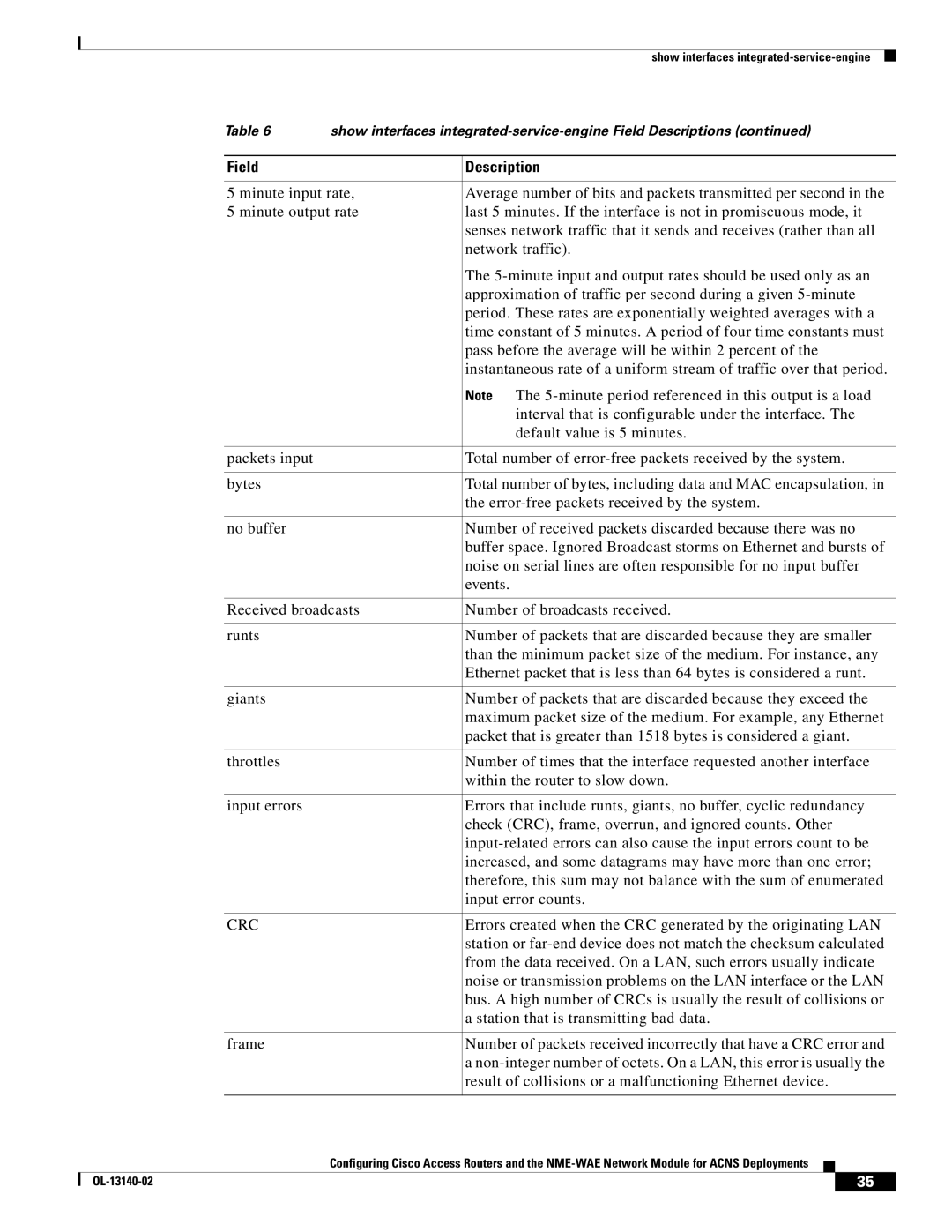|
|
|
|
|
|
|
|
|
|
|
|
| show interfaces |
| |||
|
| Table 6 | show interfaces | |||||
|
|
|
|
| ||||
|
| Field |
| Description | ||||
|
|
|
| |||||
|
| 5 minute input rate, | Average number of bits and packets transmitted per second in the | |||||
|
| 5 minute output rate | last 5 minutes. If the interface is not in promiscuous mode, it | |||||
|
|
|
| senses network traffic that it sends and receives (rather than all | ||||
|
|
|
| network traffic). | ||||
|
|
|
| The | ||||
|
|
|
| approximation of traffic per second during a given | ||||
|
|
|
| period. These rates are exponentially weighted averages with a | ||||
|
|
|
| time constant of 5 minutes. A period of four time constants must | ||||
|
|
|
| pass before the average will be within 2 percent of the | ||||
|
|
|
| instantaneous rate of a uniform stream of traffic over that period. | ||||
|
|
|
| Note The | ||||
|
|
|
| interval that is configurable under the interface. The | ||||
|
|
|
| default value is 5 minutes. | ||||
|
|
|
|
| ||||
|
| packets input |
| Total number of | ||||
|
|
|
|
| ||||
|
| bytes |
| Total number of bytes, including data and MAC encapsulation, in | ||||
|
|
|
| the | ||||
|
|
|
|
| ||||
|
| no buffer |
| Number of received packets discarded because there was no | ||||
|
|
|
| buffer space. Ignored Broadcast storms on Ethernet and bursts of | ||||
|
|
|
| noise on serial lines are often responsible for no input buffer | ||||
|
|
|
| events. | ||||
|
|
|
| |||||
|
| Received broadcasts | Number of broadcasts received. | |||||
|
|
|
|
| ||||
|
| runts |
| Number of packets that are discarded because they are smaller | ||||
|
|
|
| than the minimum packet size of the medium. For instance, any | ||||
|
|
|
| Ethernet packet that is less than 64 bytes is considered a runt. | ||||
|
|
|
|
| ||||
|
| giants |
| Number of packets that are discarded because they exceed the | ||||
|
|
|
| maximum packet size of the medium. For example, any Ethernet | ||||
|
|
|
| packet that is greater than 1518 bytes is considered a giant. | ||||
|
|
|
|
| ||||
|
| throttles |
| Number of times that the interface requested another interface | ||||
|
|
|
| within the router to slow down. | ||||
|
|
|
|
| ||||
|
| input errors |
| Errors that include runts, giants, no buffer, cyclic redundancy | ||||
|
|
|
| check (CRC), frame, overrun, and ignored counts. Other | ||||
|
|
|
| |||||
|
|
|
| increased, and some datagrams may have more than one error; | ||||
|
|
|
| therefore, this sum may not balance with the sum of enumerated | ||||
|
|
|
| input error counts. | ||||
|
|
|
|
| ||||
|
| CRC |
| Errors created when the CRC generated by the originating LAN | ||||
|
|
|
| station or | ||||
|
|
|
| from the data received. On a LAN, such errors usually indicate | ||||
|
|
|
| noise or transmission problems on the LAN interface or the LAN | ||||
|
|
|
| bus. A high number of CRCs is usually the result of collisions or | ||||
|
|
|
| a station that is transmitting bad data. | ||||
|
|
|
|
| ||||
|
| frame |
| Number of packets received incorrectly that have a CRC error and | ||||
|
|
|
| a | ||||
|
|
|
| result of collisions or a malfunctioning Ethernet device. | ||||
|
|
|
|
|
|
|
|
|
|
|
| Configuring Cisco Access Routers and the |
|
|
|
| |
|
|
|
| |||||
|
|
|
|
|
|
|
|
|
|
|
|
| 35 |
|
| ||
|
|
|
|
| ||||
Page 35
Image 35
